|
|
|
|
|
|
|
|
|
|
|
|
 |
|
 |
|
|
Yap State, FSM - March 1999
|
|
|
|
|
 |
|
|
|
|
|
|
|
The Project Takes Shape
|
|
|
|
|
|
|
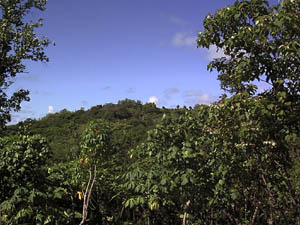
Overview of the Dinay site: Looking from the eastern ridge across the drainage to the western ridge. The site is between the two ridges. The big banyan tree is visible on the far slope just below the ridge.
March 10, 1999
Today all three of us returned to continue mapping on this one architectural complex. It is a complicated compound of structures. I think I told you already that there are two house foundations and nearly 20 other features, ranging from platforms to terraces. I would say we are just over about halfway through it. We keep finding more parts to the whole. The Japanese-era farming has erased portions of the features, disrupted alignments, and distorted other features; nature has also done its best to churn up, splay, alter, and really disfigure these same features; the combined forces cause us no end of puzzlement. Poor Mario (he is our compass man) has to wait and wait, while Andrew and I go over various features, outline mapping strategies for these features, and in the process find still more components than were at first visible during our brush-cutting episode. Andrew is responsible for the tape and mapping strategies; I do the notes, and more or less guide the two in their respective activities.
Side Note: Today, the great great nephew of Captain Crayton Holcomb, a trader who had made Yap his home and who was one of the business rivals of O'Keefe, arrived on a pilgrimage. He is visiting all the places Holcomb wrote about to his sister in Connecticut. He and his wife are very nice people, and are planning on officially presenting to the governor a book with facsimiles of all the family letters Holcomb wrote. They are thrilled at being here, and have spent their time mostly just wandering around getting the feel of the place.
Holcomb and O'Keefe were traders --- rivals, actually --- during the latter half of last century. O'Keefe is the most famous; there was even a movie made about him starring Burt Lancaster, called His Majesty O'Keefe. O'Keefe came up with the idea of assisting the Yapese in the transport of their stone money from Palau --- making it much easier for them to get their money here. It also allowed them to quarry bigger pieces of money, but had the effect of essentially devaluing the money --- because its value is based on the amount of risk in quarrying it as well as transporting it back to Yap. So, in exchange for transporting money, O'Keefe put the Yapese to work in copra fields, producing sufficient amounts for his use as trading goods.

|
At left is one of the house foundations being mapped. Visible here is the end wall and the edge of a banyan tree growing into the platform.
|
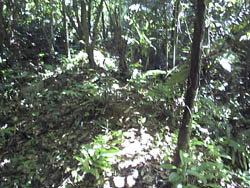
|
At left is the main stone path through this village, or what is left of it.
The path is highly eroded. Often, the only way they can follow it is to locate the fragments of retaining wall along the lower edges, or by following the drainages on either side of the path.
|
Even with our machetes it is taking us a long time. It is overun with vines that are as thick as your wrist and larger, and what we've cut is already growing back. We have to get our butts in gear to get the rest of the western part of the site cleared, or it'll have been as if we did nothing. In fact the thickness of the vegetation is part of the reason that we would find ourselves walking over house foundations and not realize it until we had gone over them, then turned back to look at what we had just walked over. It wasn't a natural feature in the landscape --- just a slight anomaly.
Now that we have been there for more than a month, the site is starting to make sense. We are seeing more and more things, recognizing the Japanese overlay, and even seeing the subtle beds made for sweet potato gardening during the Japanese era. Even the well we found early on is starting to look more and more like a Japanese feature, but one that was possibly an expansion of a traditional well --- the size of it, the debris cast off to the sides of it --- this latter is definitely not a traditional practice. The paving around the well would have been smoothed and even --- and there is no question about that paving --- there is quite a bit surrounding the well, visible at the base of the debris mounds.
March 11, 1999
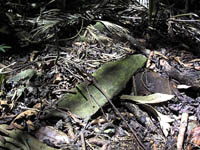 A backrest. It is laying on the ground now, but originally it had been standing up on Feature E (we don't really know what that feature is exactly, other than a stone platform --- perhaps a sitting platform) of our Daf 4 and 5 complex. A backrest. It is laying on the ground now, but originally it had been standing up on Feature E (we don't really know what that feature is exactly, other than a stone platform --- perhaps a sitting platform) of our Daf 4 and 5 complex.
Daf is the term used for house foundation. At the complex we just completed, we had these two house foundations plus a number of other platforms, retaining walls, and other features. |
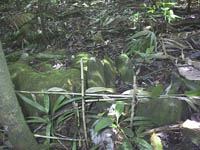 Upturned foundation stones are part of the foundation alignment on Daf 5. There is a giant curving root visible in the picture --- this has caused a portion of the schist foundation to become dislodged from its original position. Upturned foundation stones are part of the foundation alignment on Daf 5. There is a giant curving root visible in the picture --- this has caused a portion of the schist foundation to become dislodged from its original position.
The foundation is made up of slabs of schist, laid on top of one another in a horizontal pattern. You can see the relative size of these slabs in the photograph.
Tree roots, especially the big one pictured here, have disrupted this pattern of construction, and essentially thrown these stones out of place by their dramatic and continuous growth. |
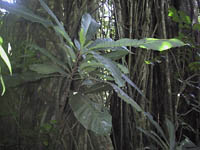 Poison tree. These are found throughout the site, although they are not thick in numbers except at one platform complex. Poison tree. These are found throughout the site, although they are not thick in numbers except at one platform complex.
This is a young one; these trees can get quite big. Their sap appears black, and you can see it oozing out of slight cuts in the tree, as well as droplets on the ground as it drips from the tree. It is a highly acidic sap that causes great irritation to your skin if you get it on you --- like a severe burn that blisters up.
Andrew was working with one archaeologist some time ago, and he ended up collecting some cuttings from a poison tree to sit on so he wouldn't have to sit on the ground. Andrew told him his leaves and such were from a poison tree, only he waved off the information as inconsequential, saying he had thick pants and underwear. Wouldn't you know it, that evening the guy got the worst blistery burn you could imagine, and it lasted for several days. Obviously he was unable to do any work on his research. |
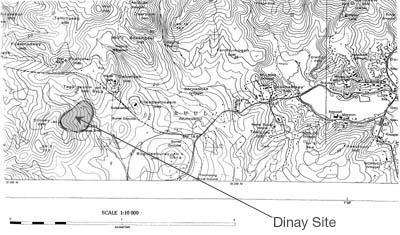

March 12, 1999
Among other things, it would be nice to start creating a chronology for here, something to keep the passage of time tidy when discussing the archaeology. I keep thinking about the comments of Tharngan in that regard, how he has noted that other archaeologists working here keep making up these chronologies based on what little work they do at late-period sites.
March 15, 1999
The only exciting thing of today was that a Coast Guard Cutter arrived. It was a big affair, with a special welcoming celebration that included dances from the girls at St. Mary's (the 6th, 7th, and 8th grades). There was an air of excitement this morning. John Tun and I were the only ones in the office, well, before 9, and he kept running out the door to see where the ship was --- outside the reef? in the channel yet? on its way to the dock? Teresa and I saw it yesterday when we were swimming at the south end of the island. It was going back and forth outside the reef; I guess it was biding its time waiting for the official docking time. The ship is supposed to be here for two or three weeks for some sort of training on-island --- search and rescue, other kinds of sea maneuvers. The FSM and the State patrol boats will be involved, and, rumor has it, a patrol boat from Palau will also be involved.
March 16, 1999
I got my teeth checked by the Coast Guard dentist. They set up a small office here, and tomorrow, if it doesn't rain (which means I get my girls at the office --- when it rains, Flavvy takes them to her house), I will have Teresa get a check-up. Sort of a nice little service. And very nice fellows.
It rained a lot today, starting when we were in the middle of the field. So Andrew and I got soaking wet. But we managed to get the cemetery cleaned up and ready for mapping, and we cut steps into a rather steep slope for the College of Micronesia students tomorrow. I am now getting warm, with coffee; I managed to get some hot water for a shower. We have to prepare for a BBQ tonight for the relatives of Capt. Crayton Holcomb --- they are presenting a book of their great great uncle's letters back to Connecticut, and some sort of plaque to the Governor. I have to bring a salad.
Later --- It was pouring when Teresa and I went down the hill to the ESA Hotel, where we (the descendants of Capt. Holcomb, Mike Caldwell from College of Micronesia, and another Dept. of Ed. person) were supposed to gather, figure out who was riding with who, and then essentially caravan out to the other end of the island: Gagil Municipality, at the beach beyond Gachpar Village. The Dept. of Ed. person dropped out because of the rain; he also was afraid the roads would be bad. I kept saying the roads are good --- sure they are dirt, but they are kept in good condition because communities are responsible for that, and if a road is in bad condition, it is a disgrace to the community. The Yapese had already gathered --- this much I knew. Finally, Mrs. Gutierrez asked me if it would be an insult for them to simply not show up. We got into Mike Caldwell's car and made our way out there. The roads were clear, the skies were clearing, so that by the time we got out to the beach, it was still cloudy, but there was a steady wind and not a drop of rain. (The clouds actually blew out a little later to reveal a beautiful star filled sky.)
The amount of food brought was unbelievable. Lobster, crab, chicken, pork, taro, tapioca, cooked bananas, rices of various kinds and a couple of salads --- my tossed green, and another with broccoli and shrimp in it. By the time dinner was ready (the chicken was cooked), Teresa was asleep. She managed to eat a bit of chicken, even some lobster and crab. But she was one tired kid. There was a formal presentation of Capt. Holcomb's letters to the governor, as well as a plaque. Speeches all around. The usual stuff. Those in attendance were a couple of paramount chiefs from the Council of Pilung, a couple of senators, and the governor, obviously. Of course my favorite paramount chief was there, Chief Andrew --- he is not only very eloquent, but quite intelligent and has a good sense of humor. His first comment to me was, "hey, like the hat! When we said goodbye, both of us very visibly and somewhat dramatically wiped our hands on our pants (our hands were covered with food residues) before we shook hands, which cracked up everyone at the table. It also seemed to serve as an ice-breaker, as a couple of the Americans at the table all of a sudden piped up and introduced themselves to me --- these are people I have seen around town, who you look at and prepare to say hello. I noticed that they were calling the chief by his more formal Yapese name --- Chief Ruepong. To me he is Chief Andrew, a more informal basis probably, but one picked up from Tharngan, who calls him that.
March 17, 1999
The tour of the site went well, I think. There were even questions from some of the kids as well as questions from their teacher, who is a really young guy. Beyond that, me and the boys were able to complete mapping of the graves and surrounding features on site. So tomorrow we get to clean up and prepare one of the larger foundations for mapping. I think Andrew is feeling a bit slow like me. It was just him and me yesterday, and both of us got the shivers. He said as soon as he got in, he cleaned up and went to bed.
Tharngan didn't show up to take us to the site, or to pick us up today. We got a ride to the site with a couple of guys from the Coast Guard who wanted to join the site tour. But coming back was another matter. Tharngan never showed to pick us up, nor was the truck brought to the office for our use. So we walked back to Colonia. We now know it takes about 45 minutes to walk from the site to the office.
Side note. How Yap got its name: A long time ago, when the Spaniards passed through here they were trying to communicate with the people. One of the questions they asked, or rather signed, was what is the name of your place. To understand the answer, you must be aware that when the Spaniards arrived, people jumped in their canoes and sailed out to meet these big ships. So when the question was signed, the last bit, "your place" was done with a gesture that pointed down to the navigator of the canoe. The answer, "Uap", is the name of the navigator --- not his personal name, but that position in the canoe.
March 18, 1999
A rather bizarre thing today --- I was on the basketball court watching the Coast Guard send off flares to show their students the different kinds. (I think they just liked lighting the flares off, frankly.) So the Navy surgeon comes up to me and says, Are you somebody? I've seen you on the dock, and you were watching everything and really paying attention. You don't seem to be like others, you're not a tourist or anything, you seem different, like you belong here, like you have some special goal or something.
I told him who I was and what I did, but I found his comments a little puzzling on the one hand, and a compliment on the other. At least I give the outward appearance that I am comfortable enough in what I do and where I am. That's encouraging.
March 19, 1999
I think we tired out Mario yesterday. That was the only day this week he has joined us in the field; and he will not be joining us tomorrow, as he is supposed to go to Fais to inspect the completion of a traditional award project --- a community house they just built. The inspection has to be completed before the community receives the small stipend alotted for this purpose by the legislature. Today we started off the day with Andrew getting a couple of teeth pulled by the Navy dentist. (The Coast Guard brought Navy doctors with them, so some are working at the hospital; the dentist set up shop by our office, and I don't know who else came along for the trip.) I suggested that we not do anything for today, and that Andrew just go home because when the novocain wears off, his mouth is going to really hurt. He didn't want to do that, and insisted we go out.
The good part about the location of the site is that it is fairly close to where he lives. I told him this morning, upon arrival, that we can quit any time he wants, and that he can simply go on home. (I kept repeating that throughout the day, too.) He was fine as long as his mouth was numb, and he did a bit of work. It is really rather fun clearing off these platform complexes and preparing them for mapping, because you end up seeing much more in the process. We ended up finding a series of steps on a stone path leading up to this platform complex. The stones had been scavenged at some point in time, probably during the Japanese gardening period, but the contours of the path and steps were sill there, along with the little filler stone matterials that go into making a stone pavement. We were able to connect the steps and path with the platform complex; but we lost the trail of where it might lead away from the complex because of the gardening.
Andrew's pain medication wore off about midway through our day in the field, so he really didn't do much of anything else. And I was not going to push him, either. So I let him rest and sit while I puttered around looking at mapping avenues and such. When our ride came, I insisted strongly that we drop Andrew at his home --- he had no choice at that point. That is what we did.
Teresa's geckos were really funny last night. As she was going to bed, she and I watched a couple of geckos --- one on the wall. It actually leaped from the wall to the cord that raises and lowers the blinds, and swung there for a bit, then jumped back to the wall again. Another was licking a flower petal that had fallen to the floor. Just put its little foot on the petal as if to hold it down, and licked it with this big long ol' tongue. Between licks, it would look up at us, watch us I suppose to see what we were doing, then go back to its task. And, in the living room, what falls from the grass skirts? A baby gecko ---- a brand new one, as far as I could tell --- with this really big head, and a body that was like a string --- very very tiny. I was afraid I would step on it. I don't think I did.
March 21, 1999
Working out in the jungles of Yap is an experience. On days like this, when it starts out hot with a very light breeze, the jungle becomes steamy hot and more humid than usual. You can't feel the breeze because of the tree cover, but you at least get some shade. It is days like this that you get those pesky heat headaches. Andrew and I spent today mapping the remainder of the adjoining features on this one platform complex we have been working on, and the rest of the time we spent preparing the other features for mapping. Cutting away some more vegetation, clearing lines of sight for our mapping, and in essence, planning the course of mapping over the next couple of days.
I look at our clearing work when we first entered the site --- removing the big brush and vines --- and look at it now, where we are removing the smaller vegetation and actually exposing more details within a platform complex. We have managed to actually expand features, like the path that leads to our Daf 6 complex (the one we are working on currently); we started with two steps unconnected (physically) to the platforms. When we finished with our clearing-for-detail, we managed to find two more steps and a good section of the path that connects with the platforms.
Today, what did we find: an extension of a retaining wall adjacent to a drainage downslope from Daf 6. Last Friday, with this notion of detail in mind, we ran across another stone path segment. This one joins the path by the well. It is a short segment with virtually no paving left, except for a small portion along one edge that has been buried by leaves and vegetation, and a bit remaining under the roots of the banyan tree that grows at the intersection of this path and the one by the well. This latter section has also been covered by ferns and fallen leaves. In our zealousness to ensure that our machetes are sharp each day, we hack away at little bits of vegetation as we hike to the upper portion of the site --- slowly, gradually we have been cutting the plants along our passage, and in the process, gradually exposing the paved edge of this path. We have begun to take note of the smaller pebbles and cobbles that occur along this route --- they are the small pebbles and cobbles one usually finds as filler in pavements and paths. And this filler is not found beyond the limits of the pathway, which provides us a bit more security in our interpretation.
Clearing-for-detail is a lot like uncovering hidden treasure, which in this case amounts to a site and its many levels of occupation and patterns of use, some of it, perhaps, from the earliest settment of the island. It's quite exciting.
March 22, 1999
I have to get my maps together, which means making several more. I have to update the Council of Pilung on our work. I'll be at this most of the evening.
Next: Dinay: Making a picture of the site
|
|
|
|